When we watch movies, my mother always cries at goodbyes. Me, I cry at arrivals. This is just one of the many things that separate us.
She cries in the moments you might expect someone to cry: the ending of Where the Red Fern Grows; the opening montage of Up; when Mufasa is killed. My dad loves telling the story about catching her red-eyed, watching My Little Pony and weeping. I came home from work and I thought something terrible had happened, she was bawling so hard, he said. I thought someone was dead. But it was just Pinkie Pie and Rainbow Dash exchanging a tearful farewell.
As a kid, I would roll my eyes at her every time: You’re crying? Again? It’s an early example of the ways we would never understand each other. Cinematic sadness rarely gets me down. You think I cried for Jack in Titanic? I did not.
Now that I’m older, though, when and what brings me to tears is starting to feel more significant. I can’t sit through the moment the Riders of Rohan appear in Lord of the Rings: The Two Towers without my eyes watering up. All night at Helm’s Deep, Théoden’s army, alongside Aragorn, Legolas, and Gimli, have fought greatheartedly against the Uruk-hai, but they have lost their ground. They ride out one more time as dawn arrives, but the Uruk are just too many. The heroes are overwhelmed. It is abundantly clear they are about to lose.
And then.
Tolkien says it best himself: “There suddenly upon a ridge appeared a rider, clad in white, shining in the rising sun. Over the hills the horns were sounding. Behind him, hastening down the long slopes, were a thousand men on foot; their swords were in their hands. Amid them strode a man tall and strong. His shield was red. As he came to the valley’s brink, he set to his lips a great black horn and blew a ringing blast.”
In the Peter Jackson movie version, they are on horseback. The music swells. On the horizon, Gandalf astride a white horse. Next to him Éomer, shouting, “To the King!” It’s the moment that changes the tide of the battle: from there, it is minutes’ work for the heroes to gain ground, for the Uruk to fall back, for the day to be won.
Buy the Book
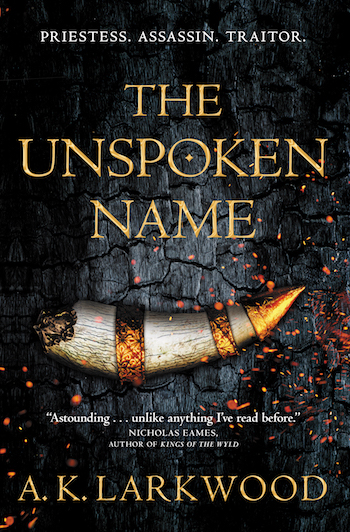

The Unspoken Name
The Two Towers premiered in 2002, but I would think of this moment again over ten years later while watching Jurassic World with a friend. When Owen (Chris Pratt) held the head of the dying Apatosaurus, I thought, Mom would cry so hard at this. I was shaking my head. Don’t get me wrong: it’s a sad scene. I just didn’t have any tears.
That is, until later, during the final battle scene with the Indominus Rex. Things are going poorly for our heroes. Indominus has pretty much decimated all the raptors. The T-Rex, our heroes’ last hope, is down. Indominus approaches; she opens her jowls. It is abundantly clear they are about to lose.
And then.
There is a beat, just one, in the music. In the distance, a small dinosaur scream. The music lifts and—there!—the raptor Blue charges out of the wreckage and launches toward the back of the beast.
That’s where I started crying, all snotty and sniffling and obvious, surprising myself and the friend next to me.
Turns out I am a sucker for this kind of moment. I’m talking goosebumps and tears and guttural sounds. Even writing this, I’ve given myself chills.
Let me give you another example (spoilers for the Avengers franchise ahead!): I was completely dry-eyed when half of the Avengers turn to dust in Infinity Wars—even though both Dr. Strange and Spider-Man, my favorites, disappear—but I completely lost it in Endgame, when Thanos has beaten Captain America nearly senseless, and as Cap rises again, there’s a soft, small voice in his ear… cue Sam: “On your left.”
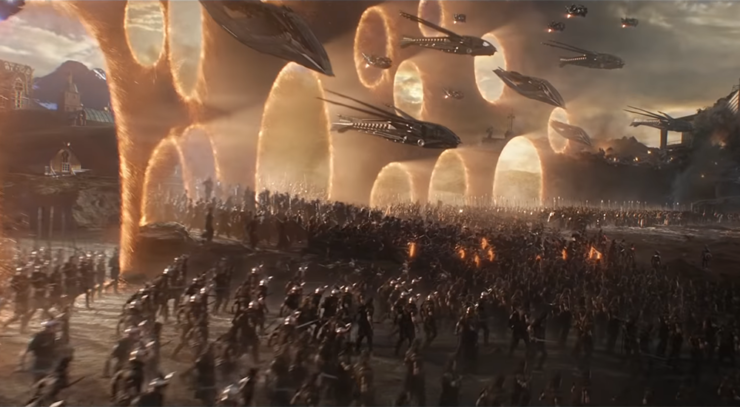
I’ve taken to calling this type of narrative turn “the rally,” or “the Riders of Rohan phenomenon,” after the scene when I first noticed it, and the effect it has on me. I’ve tried googling it—the specific moment I’m talking about doesn’t appear to have a name. It’s important to stress that the rally is not the climax—it’s certainly part of what one could call “the climactic scene,” but it’s not the actual moment of climax (after all, when the Riders of Rohan appear on the horizon, the battle isn’t actually over).
Sometimes the two might come so closely together it seems to be the same, but in other stories—like Jurassic World—it’s clear they’re separate: The RoR moment is when Blue arrives on the scene; the climax is when Indominus Rex is snapped up by the Mosasaurus some minutes later. Or in The Return of the King, the climax is when Frodo casts the One Ring into the fires of Mount Doom; the RoR moment is several scenes before, when Frodo, defeated, collapses on the ground, and Sam says, “I can’t carry it for you, but I can carry you.” So the RoR moment falls somewhere between “the dark night of the soul” and the climactic scene—indeed, it marks the transition from one to the other.
A term that almost comes close to defining this moment is Tolkien’s own word “eucatastrophe,” or “the sudden happy turn in a story which pierces you with a joy that brings tears.” You’d think, the way I always cry at the RoR phenomenon, this term would fit perfectly; but while it applies to scenes related to what I’m describing, it isn’t exactly the same. For example, Homeward Bound: The Incredible Journey features a eucatastrophe. Chance the bulldog and Sassy the cat have made it home, but Shadow the Golden Retriever isn’t with them—he couldn’t get out of the mud pit. His young owner, Peter, stares across the field. He waits. “He was old,” he says. “It was too far.” He turns back toward the house—and then. On the horizon, a golden head appears. There’s Shadow, coming home. There’s Peter, running. And there’s me…well, you know.
In this case, Shadow appearing on the ridge is a eucatastrophe. But it’s not a Riders of Rohan phenomenon. Tolkien calls Christ’s resurrection a eucatastrophe. In his own work, a frequently cited example is when Gollum attacks Frodo and thereby ensures the destruction of the One Ring. Neither of these are Riders of Rohan moments, either.
What’s the distinction I’m making between the Riders of Rohan phenomenon and eucatastrophe? Consider the difference between when Gollum fights Frodo at the edge of Mount Doom and the earlier moment when Sam carries Frodo. What makes one a RoR moment and the other not is simple: friendship. Gollum’s attack on Frodo is random, violent, and selfish, and the resulting happy ending is mere coincidence (a “sudden happy turn”); Sam makes the decision to help Frodo in his time of need and their resulting success is made possible through teamwork. So while you might argue that all RoR moments are eucatastrophes, not all eucatastrophes are RoR moments. The Riders of Rohan phenomenon is a specific kind of eucatastrophe that warrants a closer look.
The RoR phenomenon should likewise not be confused with deus ex machina (literally “god from the machine”), the well-known narrative device in which an unwinnable situation is resolved by the sudden appearance of a deity or other unlikely occurrence outside of the hero’s control. In The Lord of the Rings, the Eagles are the prime example of deus ex machina—such sudden arrivals of aid, though serving a similar narrative function as the Riders of Rohan, are in fact quite distinct (and don’t have the same effect on me, personally). It boils down, again, to the relationships and motivations involved: Sam is Frodo’s partner, someone to fight with but not for him. And that’s quite different from a mystical mostly-absent feathery creature magically dispatched only in times of great need.
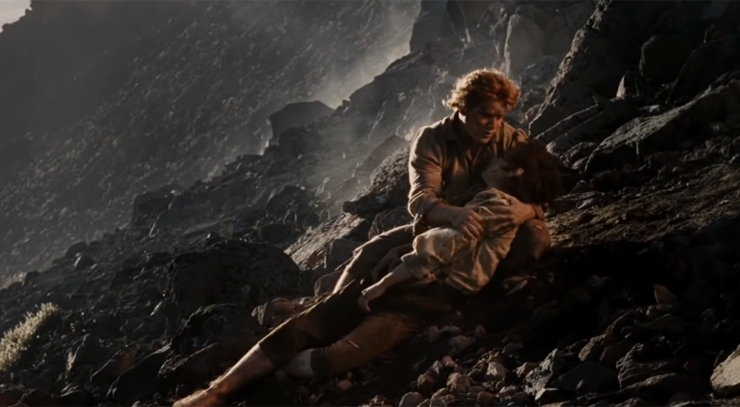
To qualify as a Riders of Rohan phenomenon, then, the relationships must be between comrades: Sam carrying Frodo on his back. The Avengers surrounding Cap. A raptor, fighting a much larger predator for the sake of a human she loves and has bonded with. The Rohirrim, coming to the aid of the king who’d banished them. People who would have otherwise been alone suddenly aren’t. And in all these cases, it’s their friends that are there for them—not coincidence, not a divine being, not even a parent or authority figure, but the people they have chosen, who have chosen them.
I’m interested in naming and studying this key rally or turning point both as a narrative tool and for its cultural significance. While I don’t intend to set up a false dichotomy—plenty of people cry at sad and joyful scenes, or never cry at movies at all—I asked other sci-fi and fantasy fans how they respond to the Riders of Rohan appearing on the horizon, and I discovered I’m far from the only one who cries exclusively at that moment. Several conversations in several bars (seriously, ask anyone who knows me—I never shut up about this) revealed many others in my chosen communities who felt the same. One friend explained that “sad movies are just like meh” to her—but show her “moments where people find a ray of hope in the midst of despair,” she said, “and I am broken.”
What is it about this moment that speaks to so many people? What is so powerful about those figures on the horizon? Does it have to do with hope? The tenacity of the human spirit?
Some people I’ve spoken with think so. Several of them explained that these displays of “hopefulness in the face of seemingly impossible odds” used to be really moving to them. Those who are not as affected by the RoR phenomenon as they used to be now feel more connected to the moments of complete despair just before it. They wondered if the change had occurred because they were feeling more cynical or pessimistic about the world these days, which suggests that the Riders of Rohan are a symbol of optimism, and that it may be this metaphorical message that viewers are responding to.
I certainly see how this might explain why these moments matter, but for me, that’s not quite it. After all, though I’m deeply moved when Aragorn convinces Théoden to ride out with him in the name of Rohan—that mouse-charging-a-lion display of optimism and courage—I don’t actually cry until I see those riders on the horizon. I think the real heart of what makes this phenomenon so powerful is in the very name I’ve given it: Riders—plural, as in a group—of Rohan—as in belonging to a place, a community.
This isn’t just a “sudden happy turn” in a narrative: as I’ve argued, what sets these scenes apart from other kinds of eucatastrophes is that the RoR phenomenon is specifically a choice made by a community. This is the moment your team shows up. Another friend agreed, explaining, “What makes these scenes so important is that often it’s chosen family who is arriving in these moments of great need, when things are darkest and most unwinnable.” She stressed the importance of “chosen family” for “marginalized people, queer people, single people,” and explained that “having people show up for you (especially in force) when you’re in crisis…is something deeply felt for people with chosen family in particular.”
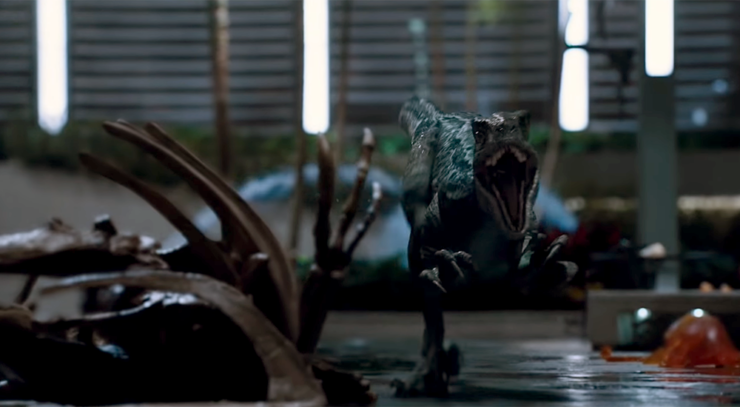
In other words, it matters that in the Riders of Rohan phenomenon the reinforcements are not religious entities or even family members, but peers and pals. It matters to people who have been isolated for their race, religion, sexuality, gender. It matters to people who don’t get along with their mothers.
Though there are several kinds of narratives that might contain such a rally (sports movies come to mind—and this “Lost Puppy” Budweiser commercial, which is only one minute long and still makes me cry), there is something within the RoR phenomenon that feels unique to science fiction and fantasy genres. For me, what science fiction and fantasy stories do best is make spaces to belong for those who traditionally do not belong. Nothing says I don’t fit in here like stories about superheroes, aliens, hobbits leaving home.
In his essay “On Fairy Stories,” Tolkien speaks to the “Consolation of the Happy Ending” being a requirement of fantasy—the guarantee of dawn after darkness. But what I want to emphasize is that the quality of Companionship is just as necessary, if not more so, than the three aspects—“Recovery, Escape, Consolation”—that Tolkien finds vital to the fantasy genre (after all, “Frodo wouldn’t have got far without Sam”).
Such stories allow people who have long felt on the outside of society, isolated perhaps even from their own families, to find representations of themselves in these narratives. And for such viewers—those like me, whose life has been spent searching for family who sees the world like I do—I argue that the greatest “Consolation” of the fantasy genre isn’t the happy ending: it’s Companionship. The promise not just of dawn but of community. Even more than that: the implication that it is the community who will bring the dawn.
That’s why I cry. It’s not simply because it’s happy. It’s not for optimism or hope or even joy that tears come to my eyes when the Riders of Rohan, in whatever form, in whatever film, suddenly appear: A voice on your left. Your herd, your team, at your back. These characters aren’t a metaphor or symbol; they’re just present. I’m crying because someone showed up.
Originally published in October 2019.
 Samantha Edmonds is the author of the prose chapbooks Pretty to Think So (Selcouth Station Press, 2019) and The Space Poet (forthcoming from Split Lip Press). Her nonfiction and cultural essays have been published in Ploughshares, The Rumpus, Literary Hub, and VICE, among others, and her fiction appears in such journals as Ninth Letter, Michigan Quarterly Review, Mississippi Review, and Black Warrior Review. She serves as the Assistant Fiction Editor for Sundress Publications and the Fiction Editor for Doubleback Review. A PhD student of creative writing at the University of Missouri, she currently lives in Columbia.
Samantha Edmonds is the author of the prose chapbooks Pretty to Think So (Selcouth Station Press, 2019) and The Space Poet (forthcoming from Split Lip Press). Her nonfiction and cultural essays have been published in Ploughshares, The Rumpus, Literary Hub, and VICE, among others, and her fiction appears in such journals as Ninth Letter, Michigan Quarterly Review, Mississippi Review, and Black Warrior Review. She serves as the Assistant Fiction Editor for Sundress Publications and the Fiction Editor for Doubleback Review. A PhD student of creative writing at the University of Missouri, she currently lives in Columbia.










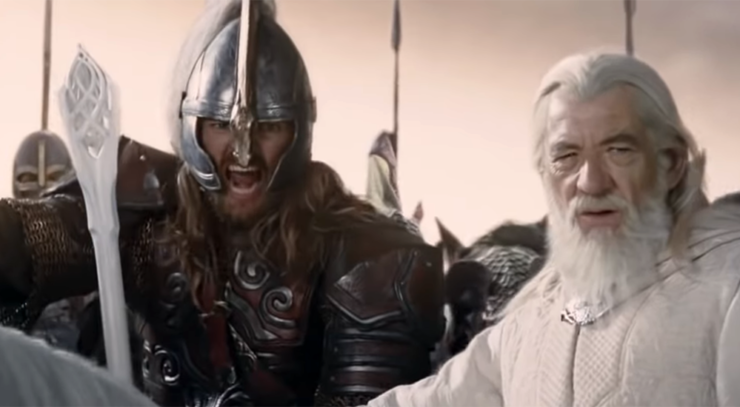
The “Rally” moment that made me cry my eyes out was in the novel of THE HUNDRED AND ONE DALMATIANS, the 1956 original not the Disneyfied nonsense that’s everywhere now, when Pongo and Perdita choose to rescue all the puppies and their community, expecting twelve, works to hide all hundred and one.
Fifty-one years after reading it for the first time, I still mist up.
This was one of my favorite Tor articles of the year and to sum up my original thoughts – I got all choked up reading it. For me the big moment was the OTHER Riders of Rohan moment – the one in Return of the King. I STILL tear up whenever I hear that horn sound. The Riders of Rohan had come at last!
I love those moments of camerederie and knowing you’re not alone. I’m so glad Rise of Skywalker did in fact have the one I wanted :D
Completely right there with you. That scene in Two Towers is the best scene in the trilogy imo, seconded to Sam carrying Frodo up the mountain. That raw fellowship is what wins wars, we see it in our own human history, and it’s far more familiar and realistic than deux ex machina. You’re right about eucastophe and the two being different, though eucastrophe is also my favorite word because the scenarios are so similar they can sometimes overlap.
In fact, I would argue that a situation where they DO overlap is in Return of the King. Our Heroes, led by Aragorn, march on the gates of Modor knowing this is only buys time. But it’s the act needed to also buy Frodo and Same time to climb Mt Doom. This is another RoR moment for Frodo, though from a distance. But then, without any knowledge of how the timing would line up, just as Aragorn and co are about to be overwhelmed, Mt Doom explodes and in an act of eucastrophe they are saved, followed by another act of eucastrophe from the eagles saving Frodo & Sam
SPOILER WARNING FOR ROS:
The scene where Rey is encouraged to keep fighting from the voices of jedi past also brought tears to my eyes, I assume you feel the same (assuming you saw the movie)
I am glad someone else gets choked up at this sort of event in a movie (or book for that matter). Another movie moment like this for me is when the Resistance shows up at Maz’s place in the Force Awakens.
I think a lot of these are in fact examples of eucatastrophe, but not every eucatastrophe involves a ‘here comes the cavalry’ moment.
And, yeah, that’s the moment I was thinking of (I wish we had SEEN them, but I was also super jazzed that they included a few characters I wasn’t expecting…which makes me wish even more we’d seen them, lol). And of course there’s the ‘it’s just people’ scene too (and can somebody refresh my memory? I feel like there’s some other famous movie where something similar happens, and it’s ‘just people’.).
Speaking of non-spoilery things, actually, my favorite moment of eucatastrophe which doesn’t quite fit this article’s definition is when Vader turns on the Emperor (you might be able to argue it is since it’s a character coming to the aid of another but I feel like that’s stretching it). When I first saw the movie I wasn’t really genre savvy enough to see where this was all going and I thought Luke was going to die and Leia would be the last Jedi. So when Vader ACTUALLY turned I just remember my jaw dropping and it was such a great moment for 14 year old me :)
While not as impacting a moment as the entire MCU roster gathering to face Thanos, I do appreciate that Rise of Skywalker took the time to gather a massive fleet of civilians and former military to face Palpatine’s fleet, with some old faces brought back such as Wedge. And hearing once again the voices of Anakin, Obi-Wan, Ahsoka, Mace, Yoda, Qui-Gon and the Rebels characters was a joy in itself, reminding us how much of the history and legacy of the Jedi are now in Rey’s hands.
I loved how David Eddings hung a lampshade on this in “Belgarath the Sorcerer” in the description of the battle of Vo Mimbre; all is lost and then Beldin shows up at the last possible second with the army all had given up hope of coming. Belgarath berates him: “Why didn’t you let me know you were here?!?” and Beldin responds something like: “Wouldn’t have been so dramatic if I did.”
TVTropes calls this “Big Damn Heroes.”
https://tvtropes.org/pmwiki/pmwiki.php/Main/BigDamnHeroes
@8 Not quite – it’s The Cavalry.
Those types of moments don’t make me tear up, but they do give me a deep satisfaction when I see them:
In “Spider-Man” when Green Goblin is about to kill Spidey and the New Yorkers on the bridge start throwing things at Green Goblin and one of them says, “You mess with one of us, you mess with ALL of us.”
In “Babylon 5” when B5 has just fought off one EarthForce assault and now a second group of cruisers and destroyers has arrived, and then Delenn arrives with a WhiteStar and several Minbari warships to defend it. (Of course, B5 took so much of its heart and soul from Tolkien, it probably should’ve paid royalties.)
And of course, “On your left,” from “Avengers: Endgame.”
It’s not JUST the cavalry arriving in the nick of time. It’s that, to the heroes, they are an UNHOPED FOR cavalry arriving in the nick of time, because the heroes thought they were on their own, but the people they’ve helped and the friends they’ve made do not abandon them.
Wow, this is ME. Even during simply anticipatory moments it can get me. Like in TTT in the anticipation of the Battle of Helm’s Deep. When the elves show up…”How is this possible?!?!” “You are MOST welcome!” Knowing that another party is willing & able to step up and bleed with you is one of the most satisfying things I can think of. (a real moment happened to me during a paintball game many years ago; I was pinned down on a flank, and after a few moments I hear fire whizzing by my head coming from behind me–my 2 best buds had come to help me. Holy shit, I’m tearing up just recalling that moment of elation!!)
for me, there are two scenes in the Wheel of Time that make one of these moments
1. when Nynaeve gets the gem merchant to remember his Malkieri roots and pledge himself to Lan
2. when Lan finally gives in and agrees to lead his people
”The Golden Crane flies for Tarmon Guidon!”
I bawl every time..
I must say I’m conflicted about this particular topic. When done right and set up properly, It really moves me, even if it is somewhat dues ex machina. However, maybe because I’ve become an old crank, most instances mention fail to do so for me and come off as contrived or emotionally manipulative. This was one of the main problems I had with Peter Jackson’s The Lord of the Rings, the director is trying so hard, practically jumping up and down on your tear ducts, that you begin to feel a bit manipulated. Endless cgi horseman charging down a steep slope into a wall of pike men does not make sense and begins to feel cheesy. Same with a crazy as a loon, sloppy eating Denethor munching away while is son makes a tactically and strategically stupid cavalry charge against a (partially ruined) city. Or sprinkling a few crumbs on a sleeping person to make it look like he ate all the food, causing his oldest friend/mentor to send him away (what’s he supposed to do, catch a bus home?).
This is why the later Star Wars movies have not done a whole lot for me: they’re so nonsensical and illogical, its hard to take them at all seriously, even if the moment itself is reasonably well executed. I guess you could poke plot holes in movies all day long, and the original movies where hardly paragons of reason, but I get the impression that things like subtlety, nuance and logic get lost in a wash of cgi and explosions.
@gadget, I am way ahead of you on the Jackwson LotR movies. I watched the first one when it came out, said, “Wow, that’s manipulative and has long scenes of … horses riding around? In close shots, so you can’t even really see clearly what’s happening? And then people emote at the camera?” Then I never watched any of the others, or any other Peter Jackson movie.
This was a bit of a fail moment for me in “Rise of Skywalker”. You could tell they were going for it, but it was just way too plainly set up and anticipated, to have much impact. I think there needs to be a bit of a surprise element, where you can’t really anticipate or count on it, for it to have the punch.
Wow, I’ve never had this so plainly explained before, but this is totally where I am with crying at movies, too.
This scene works even in films I don’t LIKE. It got me in that film Dunkirk which I literally walked out of for like 20 minutes at one point because it was giving me a headache from how loud it was and how boring I found it. But 1/3 of the film’s plot is about a bunch of civilians who happen to own boats choosing to risk their lives to come get a bunch of soldiers on a beach because the military’s ships keep getting shot down and they’re hoping smaller ships will be able to make it through. The audience KNOWS these boats are coming, it’s a part of history so we KNOW they make it and help get a lot of the soldiers off the beach. But the moment they arrive and the soldiers on the beach who’ve effectively lost all hope see this little ragtag bunch of fishing boats and tug boats arrive, the music fucking swells and it’s this big celebration because the boats MADE it and the soldiers have hope again and DAMN it got me. The rest of the movie sucked and it was a waste of my twenty dollars, but that exact scene still hit me. It’s community, it’s hope, it’s the promise of a happy ending on the horizon.
I think one of the things that isn’t mentioned here that is CRITICAL to these moments is the music.
I don’t think any of these moments would be as impactful as they are without the score backing it up. It usually gets real quiet either right at the start of this moment or right before this moment and then it gradually picks up in tempo and crescendos. If the music just continued as it had been prior to the RoR moment or stayed really quiet the whole time or something, it wouldn’t be the same.
People have mentioned in the comments that the moment in ROTK with the RoR moment is preceded by that single horn blasting out, a cry of hope, of promise. Before you even SEE the Rohirrim rising above the hill with the sunrise at their backs, the emotion hits you because you hear that horn and you know what it means.
The Sideways channel on YouTube goes through a whole analysis of the Avengers: Endgame portal moment where the score starts off with just a few notes and just continues adding in more characters’ themes and more instruments until it becomes an entire orchestra, the music echoing what’s happening on screen.
Like the thematic stuff gets me, too, no doubt, but I don’t think the context of the scene would be quite enough without the music.